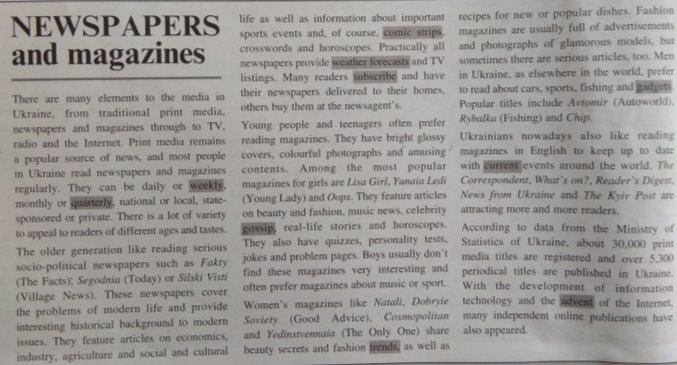Конспект уроку на тему Traditional print media in Ukraine
Lesson aim: -to practise talking about newspapers and magazines in
Objectives: -to practise using the new vocabulary and foster speaking skills on the topic;
-to teach to use mind maps for speaking about newspapers;
-to practise scanning reading;
-to teach students to write a short review of a newspaper;
-to practise using the Present Simple and should for advice;
-to encourage students to work in pairs and groups;
-to develop thinking skills;
-to make students interested in reading newspapers and magazines;
-to encourage students to use the Internet to read online publications.
Name and Surname Maria Pylypchuk
Oblast/town Volyn oblast Manevychi
School no. Manevychi secondary school №1 named after the Hero of Ukraine Andriy Snitko
Topic ‘Traditional Print Media in Ukraine’
Lesson Plan
Lesson aim: -to practise talking about newspapers and magazines in Ukraine.
Objectives: -to practise using the new vocabulary and foster speaking skills on the topic;
-to teach to use mind maps for speaking about newspapers;
-to practise scanning reading;
-to teach students to write a short review of a newspaper;
-to practise using the Present Simple and should for advice;
-to encourage students to work in pairs and groups;
-to develop thinking skills;
-to make students interested in reading newspapers and magazines;
-to encourage students to use the Internet to read online publications.
Learning outcomes:
By the end of the lesson the students are expected
- to be able to talk about newspapers in Ukraine using a mind map;
-to be able to write a short review on a newspaper issue;
-to have practised scanning reading of a short text;
-to be able to swap information about magazines in Ukraine;
-to be able to make comparison;
-to be able to give advice using should;
Teaching aids and materials: ’Solutions Pre –Intermediate‘ Workbook (2nd edition, Ukraine) by Tim Falla and Paul A Davies (OUP), p.38 ‘The media in Ukraine’, hand-outs, a presentation, a computer, the students’ smart phones, cards of different shapes and colours (for pairing and grouping), cards with the word-combinations written on them.
Lesson Procedure
I. Lead-in. Work in pairs. Ask and answer the questions.
How often do you read newspapers? What’s your favourite newspaper? Do you subscribe it or buy it at the newsagent’s? What sections in the newspapers do you like most?
II. Newspapers in Ukraine. Reading and speaking.
- Vocabulary.
a) Pronunciation and phonetics practice. Repeat the new words and word-combinations after the teacher.
( e.g. print media, modern issues, weather forecast, quarterly newspaper, etc.)
b) Students explain the meaning of the word-combinations from the text, written on cards. (The teacher holds a card above a student’s head, so he or she can’t see it, and guesses the word-combination.)
- Match the headings from the mind map with the sentences about newspapers (paragraphs 1 and 2).
a) A source of news.
b) A variety of newspapers.
c) Older people’s choice.
d) Problems and their background.
f) Articles they feature.
g) Other information they provide.
3.Listen to the teacher’s questions and match them with the headings in the mind map. Answer the questions.
Why do people read newspapers?
What newspapers do older people read?
What types of newspapers are there?
How do journalists often cover the problems?
What additional information do the socio-political newspapers contain?
4. Use the mind map to tell the class about newspapers in Ukraine.
5. Newspaper reviews.
a) Qualities of a good newspaper. Match the qualities in A with the definitions in B.
A B
1Informative a providing many useful details or ideas;
2Educational b amusing and interesting;
3Factual c based on or containing facts;
4Unbiased d teaching something you didn’t know before;
5Entertaining e fair, not influenced by other people’s opinions
b) Work in groups. The students in each group are given an issue of a newspaper (e.g. a local weekly or a national daily one).
Complete the review with the necessary information about the newspaper.
The title of the newspaper is …. It is a …, …, … newspaper. (type of the newspaper). This issue is number … and it was published on …(day of the week and date) The editor- in -chief of the issue is…(name and surname).The newspaper covers the problems of … . It contains articles on … . The issue also provides … . We think, the newspaper is …(qualities), because it is … .
c) One student from each group presents their review to the class.
III. Magazines in Ukraine.
1.Vocabulary Practice. Match a word in A with a word in B to make word-combinations.
A B
Personality covers
Fashion gossip
Glamorous content
Celebrity pages
Problem trends
Colourful tests
Glossy models
Amusing photographs
Real-life stories
2. Write questions in the Present Simple to ask about magazines in Ukraine.
a) Which / be / the most popular magazines for …?
b) What / articles /they / feature?
c) What kind / information / they / provide?
3. Scanning. Work in groups. Students of one group scan the text to answer the questions about magazines for girls. The other group look for information about women’s magazines.
4. Speaking.
a) Students work in pairs (one student from each group), swap their information and, finally, identify what the magazines have in common?
b) Giving advice.
Listen to five people, talking about their interests or needs. Which magazines would you advise them to subscribe? Why?
Person 1. I’m really into cooking. I’d like to try some new recipes. (Olha Korets,38)
Person 2. I like reading about the life of celebrities: singers, models and film stars. (Helen,17)
Person 3. Last month I started to have problems with my parents. We often argue and then I feel depressed. (Kate,14)
Person 4. I need to improve my English and I’m interested in what is happening in the world nowadays. (Oleh,22)
Person 5. My hobby is fast cars, engines and test drives. (Vladyslav Levchuk, 35)
IV. Online Newspapers.
With the development of information technology and the advent of the Internet many online publications have appeared. You can use your smart phones to surf the Net and read them. Type “Independent online newspapers in Ukraine”
What are their titles? What information do they provide? (The Kyiv Post, Breaking News, UNIAN, The Independent etc,)
V. Ending.
1. Assessment and evaluation.
2. Home assignment. Write a short text (70-80 words) about your favourite newspaper or magazine.
3. Collecting the learners’ feedback.
Which activities did you like? Which ones would you like to practise more in the next lessons?
Appendix



про публікацію авторської розробки
Додати розробку
